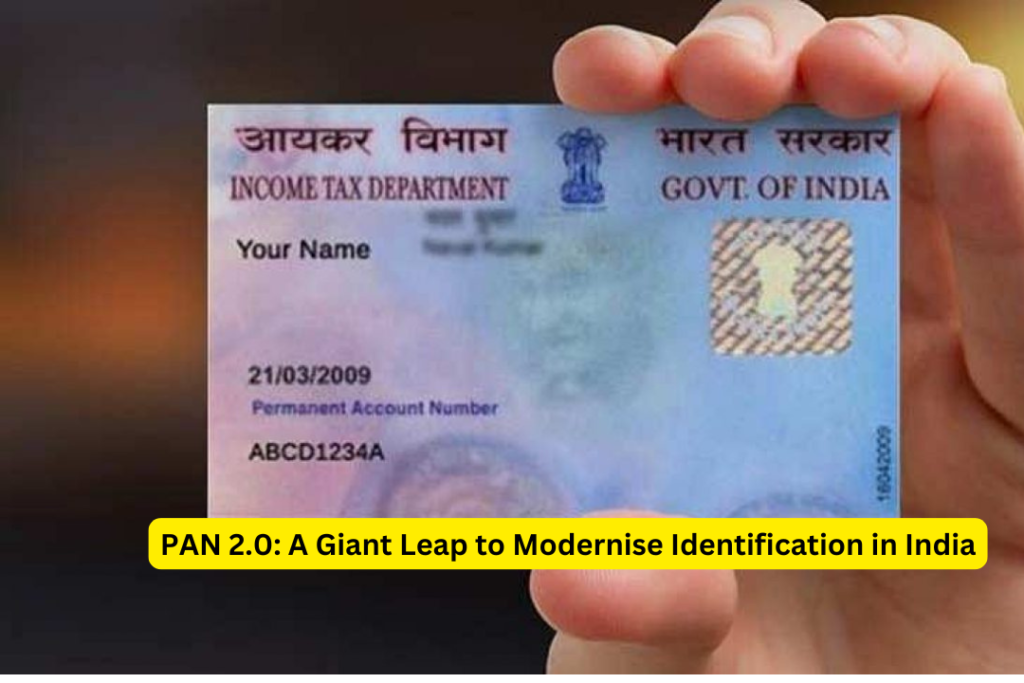The government of India recently launched an upgraded version called PAN 2.0 of its existing Permanent Account Number or PAN. The text is strongly aligned with the Digital India mission.The PAN will be developed to increase safety, speed, and accessibility in taxpayer identification and other business-related transactions. Dynamic QRs, which would redefine digital governance in India over time, and the emergence of unified business identifiers.
This blog on PAN 2.0 further elaborates the evolution, feature advantages, and implications of the future concerning the prospects of changing the country’s economic and administrative landscape.
Table of Contents
From PAN to PAN 2.0
PAN is a crucial financial identification tool in India, introduced by Section 139A of the Income Tax Act in 1972.The tax payment, financial transactions are easy with PAN, and sometimes even a recognized proof of identity is achieved.
Despite its success, the modern era has seen serious challenges come to the PAN system: Cybersecurity threats, business identifiers showing redundancy, and inefficiency in accessing it digitally. Since over 78 crore PAN cards have already been issued, and since it covers a whopping 98% eligible individuals, a revamping was much required to fulfill the requirements of a ‘digital-first economy’.
PAN 2.0-the future answer: smarter, secure, and greener in comparison to the traditional PAN card-that brings together cutting-edge technologies to modernize the process of identification, simplify compliance, and create a more inclusive financial ecosystem.
PAN 2.0: The Key Features
1. Dynamic QR Codes
One of the interesting highlights of PAN 2.0 is the dynamic QR code wherein instantaneous access to taxpayer information takes place. Unlike static information about a person in a traditional PAN card, these codes get updated dynamically and therefore, provide rapid and correct identity proof to save the time of banks, employment agencies, and governmental undertakings.
Processes that earlier on were a time-consuming process now stand simplified for example, tax audits and applications of loans, besides verifying one’s employment.
2. Unique Business Identifier (UBI)
The Unified Business Identifier is that change maker for a business whereby all identification numbers such as GSTIN, Import Export Code (IEC), besides Tax Deduction and Collection Account Numbers come under an umbrella.
Reducing redundancy, UBI has streamlined regulatory compliance and has made doing business easier, especially for start-ups and small enterprises. It also enables smooth intergovernmental departmental interactions in making the administrative processes more transparent and efficient.
3. Centralized Digital Services
PAN 2.0 has a single digital interface through which the user can access the entire PAN-related services, applications, updates, and grievance redressal. This doesn’t also require some paper work. So, it works under the government’s aims to have eco-friendly governance.
The interface should be user-friendly enough to make possible the navigation and usage, even by those without any digital literacy.
4. Advanced Cyber Security Measures
PAN 2.0 has increased encryption to prevent the leakage of sensitive taxpayer information to those who benefit from data breaches and identity theft.
Data is stored in a secure, dedicated repository for confidentiality and trust from its users.
5. Environment-Friendly and Cost-Efficient
The process does not rely much on the infrastructure and paper works hence low-cost and environmentally friendly. It is also aligned to the green economy of the government vision since it transforms all the processes into a digitized process.
Advantages for Individuals and Companies in Relation to PAN 2.0
1. Convenience in Compliance
It saves time and hassle for businesses to get into one UBI with the incorporation of multiple identifiers. It’s more of a culture of voluntary compliance, which does eliminate much administrative burden and the risk of errors.
2. Instant Verification
Dynamic QR codes on PAN 2.0 cards facilitate instant verification that cuts the time involved in processing financial transactions and government services. It would definitely help the high volume users such as banks and corporate houses.
3. Available to All
The PAN 2.0 has a central portal offering services to all, irrespective of their location or economic status. It also provides free-of-cost access to people from all walks of life.
4. Increased Security
The PAN 2.0 ensures sensitive information for it has adopted the cyber security measures, which answer long-standing questions about ensuring data safety. This improves trust in the government digital initiatives and more people accepting the system.
5. Boost to the Digital Economy
As for making India’s digital economy grow through simpler compliance and effective business processes, PAN 2.0 catalyzes the innovations that curb inefficient operation. More directly, it boosts inward foreign direct investments to be an avenue in raising a better showcase of India to the international level for lead digital governance.
Implementation of PAN 2.0
The migration to PAN 2.0 is made non-disruptive and voluntary. Existing PAN cards will continue to be valid, and the users can choose to migrate to PAN 2.0 free of cost through the centralized portal.
This way, the user can migrate at his pace without much disturbance and ensure maximum adoption of the new system.
Financial and Administrative Implications
The PAN 2.0 project is an investment worth Rs 1,435 crore, a huge amount with a great deal of returns in the long run. The system is expected to reduce paperwork, make procedures easier, and increase compliance to save resources and make things efficient across the government departments.
Digitization of services of PAN is also being considered by the government regarding reducing administrative costs and achievement of sustainable development.
Challenges and Future Directions
Although PAN 2.0 has many advantages in its implementation, there exist challenges:
1. Digital Literacy: A large-scale awareness as well as comprehension of PAN 2.0 features can be achieved, especially by rural people, through high-profile campaigns and user-friendly training programs.
2. Technical Issues: The government has to consider technical bugs, and should have robust IT infrastructure that would support the system.
3. Cyber Security Issues: There will always be the need for the ongoing update and monitoring since the protection of emerging cyber threats to public trust will come along.
4. Stakeholder Feedback: There is constant interaction with users and other stakeholders in fine-tuning the system while correcting mistakes in the changeover.
Bigger Impact on Governance
PAN 2.0 is not a renewal but a new model where India changes its mode of governance through technology that also increases transparency, efficiency, and inclusiveness for others like an emerging economy.
It is also focusing on sustainability and being environmentally friendly, which is also aligned with global goals for the preservation of the environment, making India a leader in green governance.
Conclusion
The initiative, PAN 2.0, fills the gap between the traditional identification systems and the requirements of a digital-first economy. This evolution will provide for dynamic QR codes, Unified Business Identifiers, and advance cybersecurity features, which can modify the PAN system into a more versatile, safer, and user-friendly solution.
It is through this continued step towards embracing digital innovation that PAN 2.0 represents the best of governance: efficient, inclusive and sustainable. This ranges from the individual taxpayer to businesses and simplifies compliance, enhances security, and thus fosters a modern and digitized economy.
Far-reaching in its implementation yet easily integrated, PAN 2.0 is not merely an act oftechnological upgradation but one that is a bold step towards the future-ready India.
Read more: PAN 2.0: A Giant Leap to Modernise Identification in IndiaAtal Innovation Mission 2.0: India to be Global Innovation Hub by 2028
Breaking Down the role of Artificial Intelligence in Modern SEO Strategies


